Table of Contents
In this tutorial, you will learn what heap data structure is. Also, you will find working examples of heap operations in C, C++, Java and Python.
Heap data structure is a complete binary tree that satisfies the heap property, where any given node is
- always greater than its child node/s and the key of the root node is the largest among all other nodes. This property is also called max heap property.
- always smaller than the child node/s and the key of the root node is the smallest among all other nodes. This property is also called min heap property.
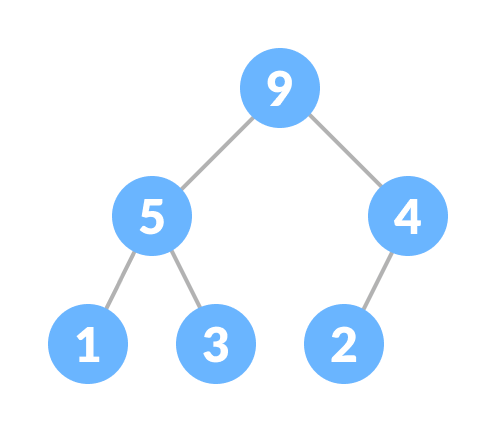
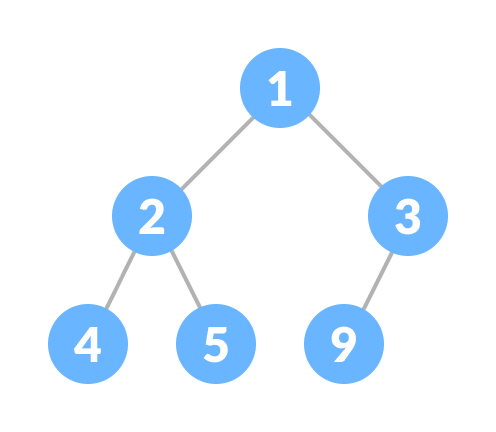
This type of data structure is also called a binary heap.
1. Heap Operations
Some of the important operations performed on a heap are described below along with their algorithms.
1.1. Heapify
Heapify is the process of creating a heap data structure from a binary tree. It is used to create a Min-Heap or a Max-Heap.
- Let the input array be
 Initial Array
Initial Array
Create a complete binary tree from the array
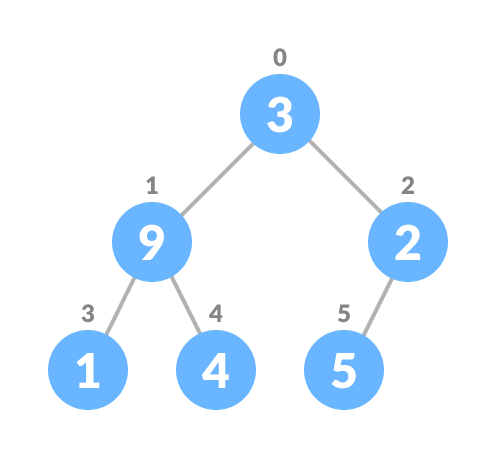
Complete binary tree
Start from the first index of non-leaf node whose index is given by n/2 - 1.
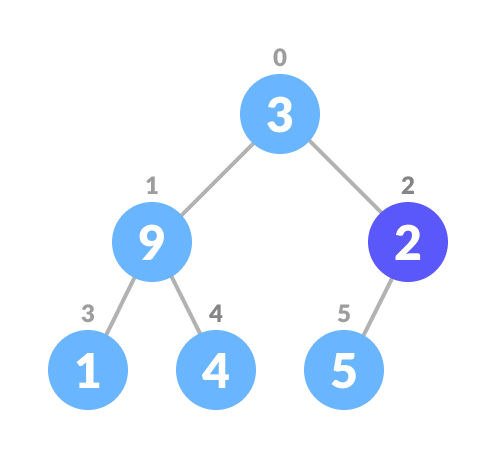
Start from the first on leaf node
- Set current element
iaslargest.
- The index of left child is given by
2i + 1and the right child is given by2i + 2. - If
leftChildis greater thancurrentElement(i.e. element atithindex), setleftChildIndexas largest. - If
rightChildis greater than element inlargest, setrightChildIndexaslargest.
Swap largest with currentElement
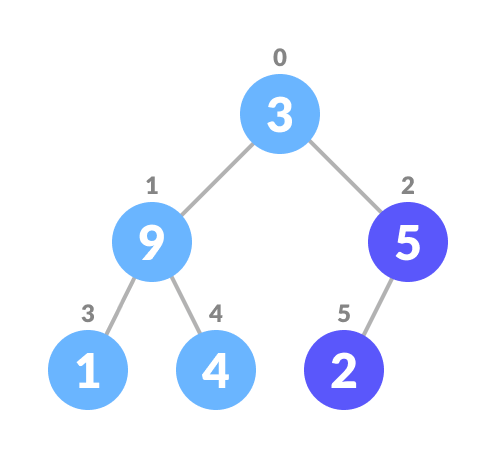
Swap if necessary
Repeat steps 3-7 until the subtrees are also heapified.
Algorithm
Heapify(array, size, i)
set i as largest
leftChild = 2i + 1
rightChild = 2i + 2
if leftChild > array[largest]
set leftChildIndex as largest
if rightChild > array[largest]
set rightChildIndex as largest
swap array[i] and array[largest]
To create a Max-Heap:
MaxHeap(array, size)
loop from the first index of non-leaf node down to zero
call heapify
For Min-Heap, both leftChild and rightChild must be smaller than the parent for all nodes.
1.2. Insert Element into Heap
Algorithm for insertion in Max Heap
If there is no node, create a newNode. else (a node is already present) insert the newNode at the end (last node from left to right.) heapify the array
- Insert the new element at the end of the tree.
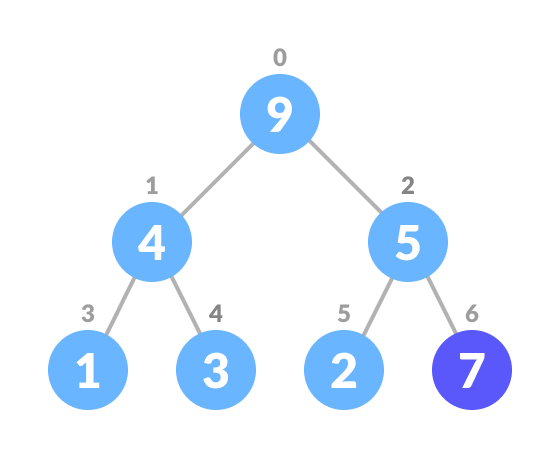
Insert at the end
- Heapify the tree.
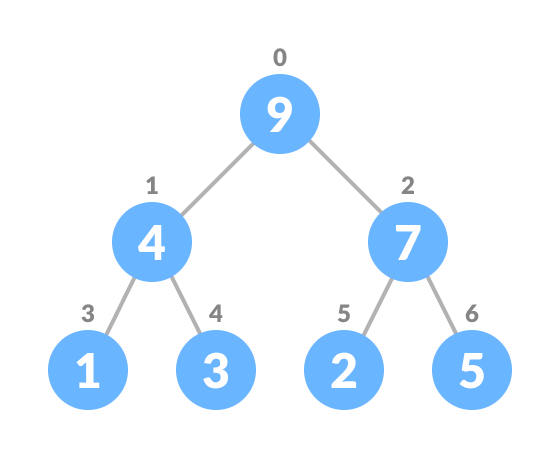
Heapify the array
For Min Heap, the above algorithm is modified so that parentNode is always smaller than newNode.
1.3. Delete Element from Heap
Algorithm for deletion in Max Heap
If nodeToBeDeleted is the leafNode remove the node Else swap nodeToBeDeleted with the lastLeafNode remove noteToBeDeleted heapify the array
Select the element to be deleted.
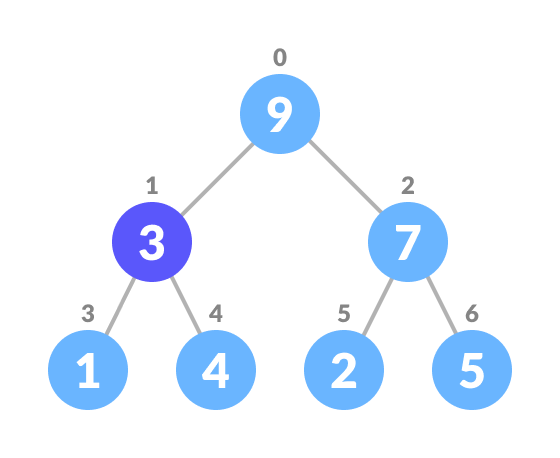
Select the element to be deleted
Swap it with the last element.
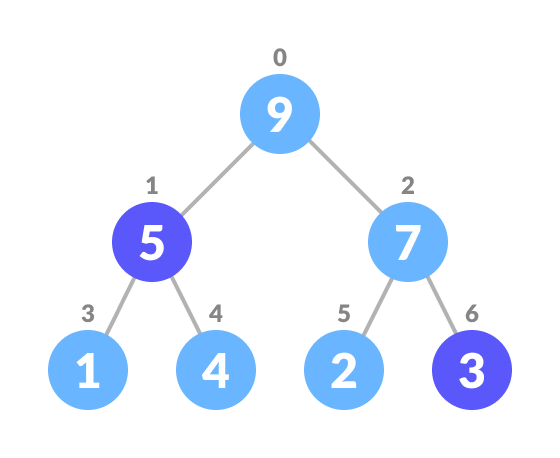
Swap with the last element
Remove the last element.
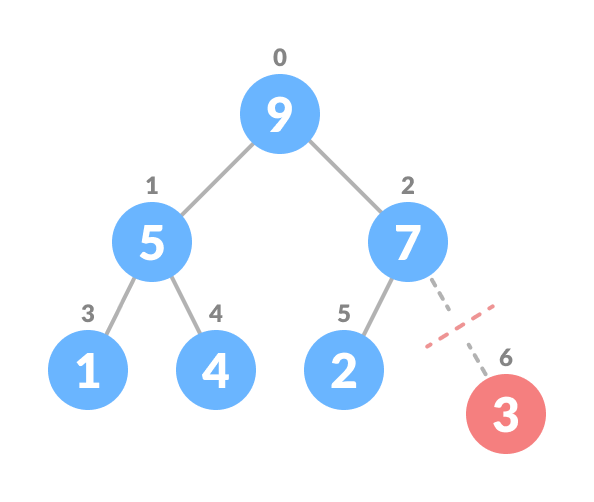
Remove the last element
Heapify the tree.
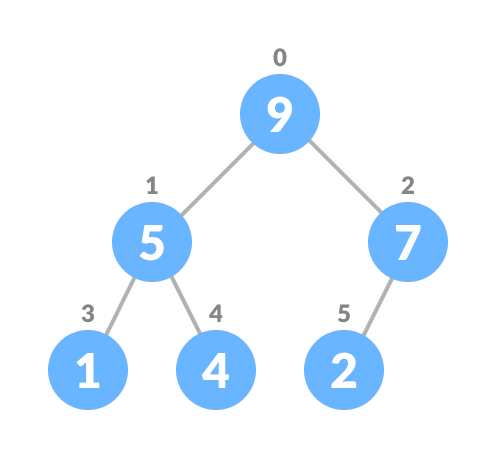
Heapify the array
For Min Heap, above algorithm is modified so that both childNodes are greater smaller than currentNode.
1.4. Peek (Find max/min)
Peek operation returns the maximum element from Max Heap or minimum element from Min Heap without deleting the node.
For both Max heap and Min Heap
return rootNode
1.5. Extract-Max/Min
Extract-Max returns the node with maximum value after removing it from a Max Heap whereas Extract-Min returns the node with minimum after removing it from Min Heap.
2. Python, Java, C/C++ Examples
Source code by Python Language:
# Max-Heap data structure in Python
def heapify(arr, n, i):
largest = i
l = 2 * i + 1
r = 2 * i + 2
if l < n and arr[i] < arr[l]:
largest = l
if r < n and arr[largest] < arr[r]:
largest = r
if largest != i:
arr[i],arr[largest] = arr[largest],arr[i]
heapify(arr, n, largest)
def insert(array, newNum):
size = len(array)
if size == 0:
array.append(newNum)
else:
array.append(newNum);
for i in range((size//2)-1, -1, -1):
heapify(array, size, i)
def deleteNode(array, num):
size = len(array)
i = 0
for i in range(0, size):
if num == array[i]:
break
array[i], array[size-1] = array[size-1], array[i]
array.remove(num)
for i in range((len(array)//2)-1, -1, -1):
heapify(array, len(array), i)
arr = []
insert(arr, 3)
insert(arr, 4)
insert(arr, 9)
insert(arr, 5)
insert(arr, 2)
print ("Max-Heap array: " + str(arr))
deleteNode(arr, 4)
print("After deleting an element: " + str(arr))
Source code by Java Language:
// Max-Heap data structure in Java
import java.util.ArrayList;
class Heap {
void heapify(ArrayList<Integer> hT, int i) {
int size = hT.size();
int largest = i;
int l = 2 * i + 1;
int r = 2 * i + 2;
if (l < size && hT.get(l) > hT.get(largest))
largest = l;
if (r < size && hT.get(r) > hT.get(largest))
largest = r;
if (largest != i) {
int temp = hT.get(largest);
hT.set(largest, hT.get(i));
hT.set(i, temp);
heapify(hT, largest);
}
}
void insert(ArrayList<Integer> hT, int newNum) {
int size = hT.size();
if (size == 0) {
hT.add(newNum);
} else {
hT.add(newNum);
for (int i = size / 2 - 1; i >= 0; i--) {
heapify(hT, i);
}
}
}
void deleteNode(ArrayList<Integer> hT, int num)
{
int size = hT.size();
int i;
for (i = 0; i < size; i++)
{
if (num == hT.get(i))
break;
}
int temp = hT.get(i);
hT.set(i, hT.get(size-1));
hT.set(size-1, temp);
hT.remove(size-1);
for (int j = size / 2 - 1; j >= 0; j--)
{
heapify(hT, j);
}
}
void printArray(ArrayList<Integer> array, int size) {
for (Integer i : array) {
System.out.print(i + " ");
}
System.out.println();
}
public static void main(String args[]) {
ArrayList<Integer> array = new ArrayList<Integer>();
int size = array.size();
Heap h = new Heap();
h.insert(array, 3);
h.insert(array, 4);
h.insert(array, 9);
h.insert(array, 5);
h.insert(array, 2);
System.out.println("Max-Heap array: ");
h.printArray(array, size);
h.deleteNode(array, 4);
System.out.println("After deleting an element: ");
h.printArray(array, size);
}
}
Source code by C Language:
// Max-Heap data structure in C
#include <stdio.h>
int size = 0;
void swap(int *a, int *b)
{
int temp = *b;
*b = *a;
*a = temp;
}
void heapify(int array[], int size, int i)
{
if (size == 1)
{
printf("Single element in the heap");
}
else
{
int largest = i;
int l = 2 * i + 1;
int r = 2 * i + 2;
if (l < size && array[l] > array[largest])
largest = l;
if (r < size && array[r] > array[largest])
largest = r;
if (largest != i)
{
swap(&array[i], &array[largest]);
heapify(array, size, largest);
}
}
}
void insert(int array[], int newNum)
{
if (size == 0)
{
array[0] = newNum;
size += 1;
}
else
{
array[size] = newNum;
size += 1;
for (int i = size / 2 - 1; i >= 0; i--)
{
heapify(array, size, i);
}
}
}
void deleteRoot(int array[], int num)
{
int i;
for (i = 0; i < size; i++)
{
if (num == array[i])
break;
}
swap(&array[i], &array[size - 1]);
size -= 1;
for (int i = size / 2 - 1; i >= 0; i--)
{
heapify(array, size, i);
}
}
void printArray(int array[], int size)
{
for (int i = 0; i < size; ++i)
printf("%d ", array[i]);
printf("\n");
}
int main()
{
int array[10];
insert(array, 3);
insert(array, 4);
insert(array, 9);
insert(array, 5);
insert(array, 2);
printf("Max-Heap array: ");
printArray(array, size);
deleteRoot(array, 4);
printf("After deleting an element: ");
printArray(array, size);
}
Source code by C++ Language:
// Max-Heap data structure in C++
#include <iostream>
#include <vector>
using namespace std;
void swap(int *a, int *b)
{
int temp = *b;
*b = *a;
*a = temp;
}
void heapify(vector<int> &hT, int i)
{
int size = hT.size();
int largest = i;
int l = 2 * i + 1;
int r = 2 * i + 2;
if (l < size && hT[l] > hT[largest])
largest = l;
if (r < size && hT[r] > hT[largest])
largest = r;
if (largest != i)
{
swap(&hT[i], &hT[largest]);
heapify(hT, largest);
}
}
void insert(vector<int> &hT, int newNum)
{
int size = hT.size();
if (size == 0)
{
hT.push_back(newNum);
}
else
{
hT.push_back(newNum);
for (int i = size / 2 - 1; i >= 0; i--)
{
heapify(hT, i);
}
}
}
void deleteNode(vector<int> &hT, int num)
{
int size = hT.size();
int i;
for (i = 0; i < size; i++)
{
if (num == hT[i])
break;
}
swap(&hT[i], &hT[size - 1]);
hT.pop_back();
for (int i = size / 2 - 1; i >= 0; i--)
{
heapify(hT, i);
}
}
void printArray(vector<int> &hT)
{
for (int i = 0; i < hT.size(); ++i)
cout << hT[i] << " ";
cout << "\n";
}
int main()
{
vector<int> heapTree;
insert(heapTree, 3);
insert(heapTree, 4);
insert(heapTree, 9);
insert(heapTree, 5);
insert(heapTree, 2);
cout << "Max-Heap array: ";
printArray(heapTree);
deleteNode(heapTree, 4);
cout << "After deleting an element: ";
printArray(heapTree);
}
3. Heap Data Structure Applications
- Heap is used while implementing a priority queue.
- Dijkstra’s Algorithm
- Heap Sort

